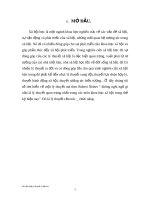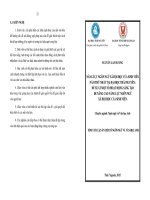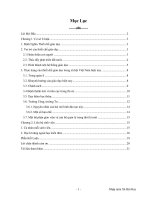TIỂU LUẬN NGÔN NGỮ XÃ HỘI HỌC
Bạn đang xem bản rút gọn của tài liệu. Xem và tải ngay bản đầy đủ của tài liệu tại đây (283.7 KB, 10 trang )
HUE UNIVERSITY
INSTITUTE OF OPEN EDUCATION
AND INFORMATION TECHNOLOGY
ENGLISH LANGUAGE
🙤🙤🙤
SOCIOLINGUISTIC PROJECT
Lecturer: PhD.Trần Thuần
Student: Nguyễn Thị Hải Yến Hải Yếni Yếnn
Student’s code: 7052900502
Class: Nghệ An 6
Examine the differences between the
Vietnamese spoken in Hanoi and its neigboring areas
and the Vietnamese spoken in the Mekong delta. Why
do you think there are such dialectal evidence?
TOPIC:
Nghệ An, 7/2023
1
The Vietnamese language, like many languages, exhibits regional variations and
dialectal differences across different parts of the country. One significant
distinction can be observed between the Vietnamese spoken in Hanoi and its
neighboring areas in northern Vietnam and the Vietnamese spoken in the
Mekong Delta in the southern part of the country. These differences arise due to
a combination of historical, geographical, cultural, and sociolinguistic factors. In
this essay, we will examine the variations between these two dialects and
explore the possible reasons behind their existence.
1.
Phonological Differences:
Phonological differences between the Vietnamese spoken in Hanoi and the
Vietnamese spoken in the Mekong Delta can be observed in several aspects of
pronunciation. These variations are influenced by regional accents and historical
linguistic developments. Here are some notable phonological differences:
1.1.
Tones:
Hanoi: The Hanoi dialect is known for its distinct rising tone patterns. It
often exhibits a more level tone for the low tone and a rising tone for the midlevel tone. Additionally, the Hanoi dialect tends to have a reduced number of
tonal contours compared to other dialects.
Mekong Delta: In the Mekong Delta dialect, the tones are characterized
by a falling or level intonation pattern. The low tone is typically pronounced
with a falling pitch contour, and the mid-level tone tends to have a level pitch
contour.
1.2.
Final Consonants:
Hanoi: In the Hanoi dialect, the final /ŋ/ sound is often omitted. Words
that end with /ŋ/ in standard Vietnamese may be pronounced without the final
nasal sound in Hanoi.
Mekong Delta: In the Mekong Delta dialect, the final /ŋ/ sound is
retained. Words that end with /ŋ/ in standard Vietnamese are pronounced with
the final nasal sound in the Mekong Delta.
1.3.
Vowels:
Hanoi: The Hanoi dialect tends to have a more centralized pronunciation
of certain vowels. For example, the vowel /a/ may be pronounced as [ə] or [ɜ],
and the vowel /ɛ/ may be pronounced as [ɪ].
2
Mekong Delta: The Mekong Delta dialect typically retains a more
traditional pronunciation of vowels compared to the Hanoi dialect.
1.4.
Rhotic Consonant:
Hanoi: The Hanoi dialect tends to have a retroflex /ɻ/ or /r/ sound for the
letter "r." It is pronounced with the tongue curled slightly back.
Mekong Delta: The Mekong Delta dialect may have a more central or
non-retroflex pronunciation of the letter "r."
2.
Lexical Differences:
Lexical differences between the Vietnamese spoken in Hanoi and the
Vietnamese spoken in the Mekong Delta can be observed in vocabulary choices,
terms used to describe certain concepts or objects, and regional colloquialisms.
These differences are influenced by historical, cultural, and regional factors.
Here are some notable lexical differences:
2.1.
Vocabulary:
- Hanoi: The Hanoi dialect tends to preserve more archaic and formal
vocabulary compared to other dialects. It often retains older loanwords from
Chinese and has a broader range of vocabulary related to academia and
governance.
- Mekong Delta: The Mekong Delta dialect may have a higher number of
loanwords from Khmer and Cham languages, reflecting the region's historical
and cultural interactions.
2.2.
Food Terminology:
-Hanoi: The Hanoi dialect may use specific terms and names for local dishes
and ingredients. Some food terminology reflects the cuisine and culinary
traditions of the northern region.
-Mekong Delta: The Mekong Delta dialect may have its own vocabulary for
local dishes and ingredients, reflecting the culinary culture and agricultural
practices of the southern region.
2.3.
Regional Colloquialisms:
-Hanoi: The Hanoi dialect may have certain colloquial expressions and slang
words that are unique to the region. These colloquialisms reflect the local
culture and the linguistic characteristics of the capital city.
3
-Mekong Delta: The Mekong Delta dialect may have its own set of colloquial
expressions and idiomatic phrases that reflect the local culture and lifestyle of
the delta region.
2.4.
Cultural and Regional Influences:
-Hanoi: Being the capital city, Hanoi has historically been a center of politics,
literature, and education. As a result, it has a significant influence on standard
Vietnamese language usage and vocabulary.
-Mekong Delta: The Mekong Delta has a unique cultural and historical
background, influenced by Khmer and Cham cultures, which can be reflected in
its vocabulary choices and linguistic expressions.
3.
Grammatical Differences:
Grammatical differences between the Vietnamese spoken in Hanoi and the
Vietnamese spoken in the Mekong Delta can be observed in the usage of certain
grammatical structures, word order, and particles employed in daily speech.
These variations are influenced by regional accents, cultural factors, and
historical linguistic developments. Here are some notable grammatical
differences:
3.1. Word Order:
- Hanoi: The Hanoi dialect generally follows the subject-verb-object (SVO)
word order, which is the standard word order in Vietnamese.
- Mekong Delta: The Mekong Delta dialect may exhibit a more flexible word
order, allowing for variations in the positioning of subject, verb, and object
elements.
3.2. Sentence Final Particles:
- Hanoi: The Hanoi dialect tends to use a wider range of sentence-final particles
to express various nuances and emotions in speech. These particles can modify
the tone or mood of a sentence.
- Mekong Delta: The Mekong Delta dialect may have its own set of sentencefinal particles that differ from those used in the Hanoi dialect.
3.3 Pronouns:
- Hanoi: In the Hanoi dialect, the use of personal pronouns to refer to oneself or
others may differ from standard Vietnamese in certain contexts.
4
- Mekong Delta: The Mekong Delta dialect may also exhibit variations in the
use of personal pronouns compared to the standard Vietnamese.
3.4. Verb Usage:
- Hanoi: The Hanoi dialect may exhibit certain verb usage variations, such as the
use of specific verbs or verb forms, in different contexts compared to the
standard Vietnamese.
- Mekong Delta: The Mekong Delta dialect may have its own set of verbs or
verb forms that differ from those used in the Hanoi dialect or standard
Vietnamese.
3.5. Regional Idioms:
- Hanoi: The Hanoi dialect may have specific idiomatic expressions and regional
phrases that differ from those used in other regions, including the Mekong Delta.
- Mekong Delta: The Mekong Delta dialect may have its own set of idiomatic
expressions and regional phrases that reflect the local culture and way of life.
4.
Sociolinguistic Factors:
Sociolinguistic factors play a crucial role in shaping language variations and
differences. The Vietnamese spoken in Hanoi and the Vietnamese spoken in the
Mekong Delta exhibit sociolinguistic differences influenced by social identity,
education, exposure to different linguistic influences, and cultural practices.
Here are some notable sociolinguistic factors that contribute to the differences
between these two dialects:
4.1. Social Identity:
- Hanoi: As the capital city of Vietnam, Hanoi has historically been a center of
political, intellectual, and cultural activities. The Hanoi dialect is often
associated with prestige and formality, as it is influenced by the standard
Vietnamese language used in education and official settings.
- Mekong Delta: The Mekong Delta has a distinct cultural identity and a more
rural and agricultural focus. The dialect spoken in this region reflects the local
customs, lifestyle, and social practices of the inhabitants.
4.2. Educational Influence:
- Hanoi: Hanoi has renowned educational institutions and universities, attracting
students from across the country. The emphasis on standard Vietnamese in
5
education contributes to the influence of the Hanoi dialect as a reference for
proper pronunciation and language use.
- Mekong Delta: The educational landscape in the Mekong Delta may have
different priorities and resources, influencing the linguistic norms and
preferences in the region.
4.3. Language Contact:
- Hanoi: Being the capital city and a cultural hub, Hanoi has experienced greater
exposure to national and international influences. Language contact with
speakers from various regions and backgrounds has led to linguistic interactions
and the adoption of certain linguistic features in the Hanoi dialect.
- Mekong Delta: The Mekong Delta, with its geographical location and cultural
connections to neighboring countries like Cambodia, has experienced language
contact with Khmer and Cham languages. This contact has contributed to the
linguistic influences and variations observed in the Mekong Delta dialect.
4.4. Migration and Settlement Patterns:
- Hanoi: Hanoi has a long history of migration and settlement, attracting people
from different regions of Vietnam. The mixture of linguistic backgrounds and
dialects among the city's inhabitants contributes to the linguistic diversity in the
Hanoi dialect.
- Mekong Delta: The Mekong Delta has also seen migration and settlement
patterns, including the influence of ethnic minority communities such as the
Khmer and Cham. This diversity of linguistic backgrounds contributes to the
linguistic variations observed in the Mekong Delta dialect.
4.5. Regional Cultural Practices:
- Hanoi: Hanoi has been the center of cultural and intellectual activities, shaping
social norms and linguistic conventions. The local cultural practices, traditions,
and historical events in Hanoi influence the language use and sociolinguistic
behaviors in the region.
- Mekong Delta: The Mekong Delta has its own distinct cultural practices,
agricultural traditions, and historical events. The regional cultural practices and
social dynamics contribute to the sociolinguistic characteristics of the Mekong
Delta dialect.
5.
Geographical and Historical Factors:
6
Geographical and historical factors have played a significant role in shaping the
differences between the Vietnamese spoken in Hanoi and the Vietnamese
spoken in the Mekong Delta. These factors include geographic location,
historical events, cultural influences, and linguistic interactions. Here are some
notable differences influenced by geographical and historical factors:
5.1. Geographic Location:
- Hanoi: Hanoi is located in the northern part of Vietnam, near the Red River
Delta. Its geographical position has exposed it to various cultural and linguistic
influences, including those from neighboring countries such as China. The
proximity to China has led to historical and linguistic interactions, resulting in
certain linguistic features in the Hanoi dialect.
- Mekong Delta: The Mekong Delta is situated in the southernmost part of
Vietnam, in the fertile plain of the Mekong River. Its location has facilitated
interactions with neighboring countries like Cambodia, contributing to cultural
exchanges and linguistic influences in the Mekong Delta dialect.
5.2. Historical Events and Migration Patterns:
- Hanoi: Hanoi has been the political and cultural center of Vietnam for
centuries. Historical events, such as the feudal dynasties and colonial rule, have
influenced the development of the Hanoi dialect and its linguistic characteristics.
The city's historical significance has also attracted migration from various
regions of Vietnam, leading to linguistic diversity and the incorporation of
different dialectal features.
- Mekong Delta: The Mekong Delta has a history of immigration and settlement.
Historical events, such as the Khmer Empire's influence, the French colonial
period, and the impact of the Vietnam War, have shaped the linguistic landscape
of the region. Migration patterns and interactions with diverse ethnic groups
have contributed to the linguistic variations observed in the Mekong Delta
dialect.
5.3. Cultural Influences:
- Hanoi: Hanoi has a rich cultural heritage and has been a center of literature,
art, and intellectual activities. The city's cultural practices, traditions, and
historical events have influenced language use and contributed to the
preservation of certain linguistic features in the Hanoi dialect.
7
- Mekong Delta: The Mekong Delta has its own distinct cultural practices,
influenced by the region's agricultural focus and ethnic diversity. Cultural
traditions, such as those of the Khmer and Cham communities, have influenced
the linguistic characteristics of the Mekong Delta dialect.
5.4. Linguistic Interactions:
- Hanoi: Hanoi has historically been a hub of education and intellectual
discourse. The concentration of educational institutions, literary works, and
standardized language usage has influenced the Hanoi dialect and its impact on
language norms and standards in Vietnam.
- Mekong Delta: The Mekong Delta has experienced linguistic interactions with
neighboring regions and countries, such as Cambodia. Language contact and the
incorporation of loanwords have contributed to the linguistic diversity and
specific features of the Mekong Delta dialect.
6.
Cultural and Ethnolinguistic Diversity:
Cultural and ethnolinguistic diversity are important factors that contribute to the
differences between the Vietnamese spoken in Hanoi and the Vietnamese
spoken in the Mekong Delta. These differences arise from the presence of
diverse ethnic groups, cultural practices, and historical influences. Here are
some notable differences influenced by cultural and ethnolinguistic diversity:
6.1. Ethnic Minority Communities:
- Hanoi: While the majority of the population in Hanoi consists of the Kinh
ethnic group, there are also smaller ethnic minority communities present. These
communities, such as the Tay, Muong, and Dao, have their own linguistic
practices and may contribute to linguistic variations within the Hanoi dialect.
- Mekong Delta: The Mekong Delta is home to various ethnic minority groups,
including the Khmer and Cham communities. These communities have their
own languages, cultural practices, and linguistic features, which influence the
Mekong Delta dialect.
6.2. Cultural Practices and Traditions:
- Hanoi: Hanoi has been the center of political and intellectual activities, shaping
the cultural practices and traditions in the region. These cultural influences may
impact language use, vocabulary choices, and sociolinguistic norms within the
Hanoi dialect.
8
- Mekong Delta: The Mekong Delta has a distinct cultural identity influenced by
its agricultural focus and the presence of ethnic minority communities. Cultural
practices and traditions, such as those of the Khmer and Cham communities,
contribute to the cultural and linguistic characteristics of the Mekong Delta
dialect.
6.3. Historical Influences:
- Hanoi: Hanoi has experienced historical influences from neighboring
countries, particularly China. These influences can be seen in cultural practices,
artistic expressions, and language borrowings, which may have an impact on the
Hanoi dialect.
- Mekong Delta: The Mekong Delta has a history of interactions with
neighboring countries, including Cambodia. Cultural exchanges, trade, and
historical events have influenced the cultural practices and linguistic features in
the Mekong Delta dialect.
6.4. Language Contact and Borrowings:
- Hanoi: Hanoi, as the capital city and a cultural hub, has historically had more
exposure to national and international influences. Language contact with
speakers from different regions and backgrounds has led to linguistic
interactions, borrowings, and the adoption of certain linguistic features within
the Hanoi dialect.
- Mekong Delta: The Mekong Delta, with its geographical location and cultural
connections to neighboring countries like Cambodia, has experienced language
contact and borrowings from the Khmer language, as well as linguistic
influences from Cham communities.
6.5. Cultural Expressions and Art Forms:
- Hanoi: Hanoi has a long tradition of literature, music, and performing arts.
Cultural expressions and art forms in Hanoi may have specific linguistic features
and vocabulary choices that reflect the local artistic and literary traditions.
- Mekong Delta: The Mekong Delta also has its own artistic traditions and
cultural expressions, influenced by the agricultural lifestyle and the presence of
ethnic minority communities. These traditions can contribute to linguistic
variations within the Mekong Delta dialect.
In conclusion, the dialectal differences between the Vietnamese spoken in Hanoi
and its neighboring areas and the Vietnamese spoken in the Mekong Delta can
9
be attributed to a combination of historical, geographical, cultural, and
sociolinguistic factors. Phonological, lexical, grammatical, and sociolinguistic
variations arise due to these influences and contribute to the rich linguistic
diversity within Vietnam. These dialectal differences reflect the unique regional
identities and histories of the areas and demonstrate the dynamic nature of
language as it evolves within different social and geographical contexts
10









